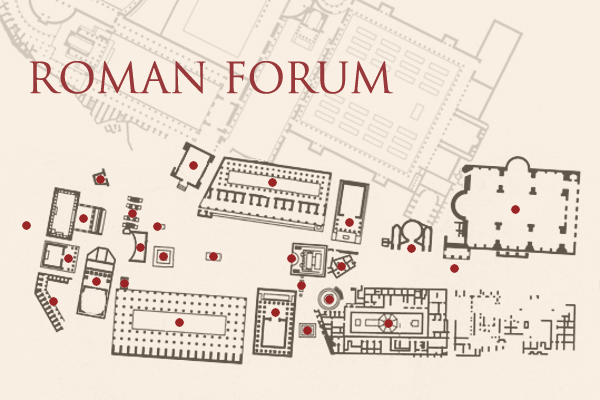Click on the dots to access the monuments.

"First among cities, the home of gods, is golden Rome."
Ausonius, The Order of Famous Cities (XI.1)
With the defeat of Antony and Cleopatra at Actium in 31 BC, Octavian, Caesar's adopted son and heir, was left undisputed ruler of Rome. Proclaimed Augustus four years later, he sought to build a capital worthy of the empire over which it ruled, boasting that he had "found Rome a city of brick and left it a city of marble" (Suetonius, Life of Augustus, XXVIII.3).And, indeed, the Roman Forum essentially is Augustan: the temples of Saturn, Concord, Castor and Pollux, Divine Julius, the Basilicas of Julia and Aemilia, the Curia and Rostra—all took their final form during his triumvirate and principate.
In AD 410, six years after the seat of imperial government had been removed to the safety of Ravenna, Rome was sacked by Alaric the Visigoth (one still can see green stains on the marble floor of the Basilica Aemilia where bronze coins had melted). In AD 455, Rome again was plundered, this time by Genseric the Vandal, who removed half the gilt-bronze tiles from the roof of the Temple of Jupiter, and then in AD 472 by Ricimer. Only a few years later, in AD 476, the last emperor was deposed and the Roman empire in the West ceased to exist. The temples, basilicas, and other monuments in the Forum eventually were abandoned and despoiled until even their names were forgotten. They were stripped of the lead and metal clamps that had joined them together, the stones reused, and the marble burned for lime to make cement. For hundreds of years, these depredations would continue until, eventually, the site would be known only as Campo Vaccino, the Cow Field.
Not until the nineteenth century would the name of the Forum be heard again.

"Builder of temples, holy rebuilder of temples"
Ovid, Fasti (II.63)
Disappointingly, some of the Forum may not be accessible; indeed, more and more seems to be fenced off as excavation continues and visitors become ever more numerous. Nor do all the ruins, no matter how historically evocative, inspire a photograph.
References: A New Topographical Dictionary of Ancient Rome (1992) by L. Richardson, Jr.; Urbs Roma (1967) by Donald R. Dudley; The Roman Forum (1970) by Michael Grant; Pictorial Dictionary of Ancient Rome (1968) by Ernest Nash; Rome: An Oxford Archaeological Guide (1998) by Amanda Claridge; Rome and Environs: An Archaeological Guide (2007) by Filippo Coarelli (an English translation of Roma, Italia Centrale, and Dintorni di Roma); A Topographical Dictionary of Ancient Rome (1929) by Samuel Ball Platner and Thomas Ashby; Roman Imperial Architecture (1981) by J. B. Ward-Perkins; The Oxford Classical Dictionary (1970) edited by N. G. L. Hammond and H. H. Scullard.